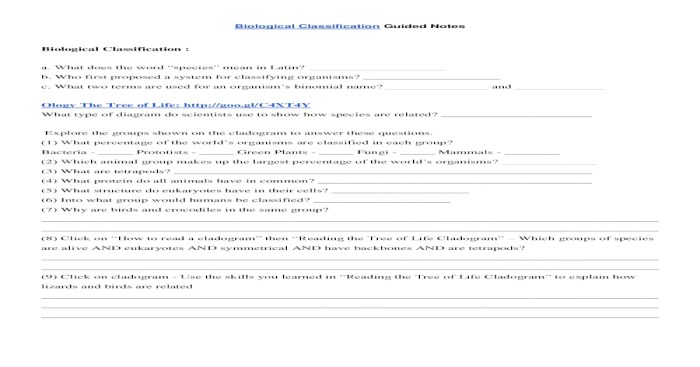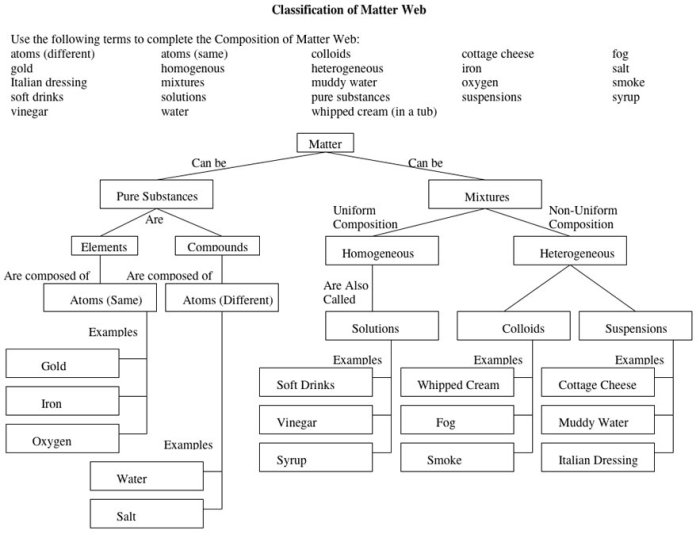Classification of matter worksheet answers pogil offers a comprehensive exploration of the fundamental concepts surrounding the classification of matter. Delving into the diverse states of matter, this guide provides a thorough overview of their properties and characteristics, supported by engaging POGIL activities that foster interactive learning and reinforce understanding.
POGIL (Process Oriented Guided Inquiry Learning) activities serve as valuable tools in science education, promoting active student engagement and fostering a deeper comprehension of scientific concepts. By incorporating hands-on experiments, collaborative discussions, and guided inquiry, POGIL activities transform the learning process, making it both enjoyable and effective.
Classification of Matter Worksheet Answers: Classification Of Matter Worksheet Answers Pogil

The classification of matter worksheet provides students with a comprehensive overview of the different states of matter and their properties. The worksheet begins by introducing the concept of matter and its three main states: solid, liquid, and gas. Students are then asked to identify the different states of matter in everyday objects and to describe their properties.
The worksheet also includes a section on the changes of state. Students are asked to identify the different ways that matter can change from one state to another and to describe the energy changes that occur during these changes. The worksheet concludes with a section on the applications of the classification of matter.
Students are asked to identify the different ways that the classification of matter is used in everyday life.
POGIL Activities
POGIL (Process Oriented Guided Inquiry Learning) activities are a type of student-centered learning activity that is designed to help students develop their critical thinking skills. POGIL activities are typically based on real-world problems and require students to work together in small groups to solve the problem.
POGIL activities have been shown to be effective in improving student understanding of science concepts and in developing their problem-solving skills.
There are a number of POGIL activities that can be used to teach the classification of matter. One activity, called “The States of Matter,” asks students to investigate the properties of different states of matter. Students are given a variety of materials, such as water, ice, and steam, and are asked to observe the properties of each material.
Students then use their observations to classify the materials as solids, liquids, or gases.
Another POGIL activity, called “Changes of State,” asks students to investigate the changes of state. Students are given a variety of materials, such as water, ice, and steam, and are asked to observe the changes that occur when the materials are heated or cooled.
Students then use their observations to explain the changes of state.
POGIL activities can be a valuable tool for teaching the classification of matter. POGIL activities are engaging and hands-on, and they allow students to learn by doing. POGIL activities also help students to develop their critical thinking skills and their problem-solving skills.
Interactive Learning, Classification of matter worksheet answers pogil
Interactive learning is a type of learning that involves active participation by the learner. Interactive learning activities can be used to teach a variety of science concepts, including the classification of matter. One interactive learning activity that can be used to teach the classification of matter is called “The States of Matter Scavenger Hunt.”
In this activity, students are given a list of clues and are asked to find objects that represent the different states of matter. Students can then use their findings to create a poster or presentation on the different states of matter.
Another interactive learning activity that can be used to teach the classification of matter is called “The Changes of State Simulation.” In this activity, students use a computer simulation to investigate the changes of state. Students can use the simulation to see how different materials change state when they are heated or cooled.
Students can also use the simulation to investigate the energy changes that occur during the changes of state.
Interactive learning activities can be a valuable tool for teaching the classification of matter. Interactive learning activities are engaging and hands-on, and they allow students to learn by doing. Interactive learning activities also help students to develop their critical thinking skills and their problem-solving skills.
Assessment and Evaluation
There are a number of different assessment methods that can be used to evaluate student understanding of the classification of matter. These methods include:
- Written tests:Written tests can be used to assess student understanding of the key concepts of the classification of matter. Written tests can also be used to assess student ability to apply their knowledge to new situations.
- Performance tasks:Performance tasks can be used to assess student ability to use the classification of matter to solve real-world problems. Performance tasks can also be used to assess student ability to communicate their understanding of the classification of matter.
- Portfolios:Portfolios can be used to assess student progress over time. Portfolios can include a variety of assessment materials, such as written work, performance tasks, and self-reflections.
The best assessment method for a particular class will depend on the specific learning objectives of the class. It is important to use a variety of assessment methods to get a complete picture of student understanding.
Here are some sample assessment questions or tasks that can be used to assess student understanding of the classification of matter:
- Define the term “matter” and describe the three main states of matter.
- Classify the following materials as solids, liquids, or gases: water, ice, steam, iron, air, and helium.
- Describe the changes of state and explain the energy changes that occur during these changes.
- Design an experiment to investigate the properties of different states of matter.
- Create a poster or presentation on the different states of matter.
FAQs
What are the benefits of using POGIL activities in science education?
POGIL activities promote active learning, enhance student engagement, foster critical thinking, and improve problem-solving skills.
How do POGIL activities enhance student understanding of the classification of matter?
POGIL activities provide hands-on experiences, facilitate collaborative learning, and encourage students to actively engage with the material, leading to a deeper understanding of the concepts.
What types of interactive learning activities can be used to teach the classification of matter?
Interactive games, simulations, experiments, and demonstrations can be used to engage students and reinforce their understanding of the different states of matter and their properties.

